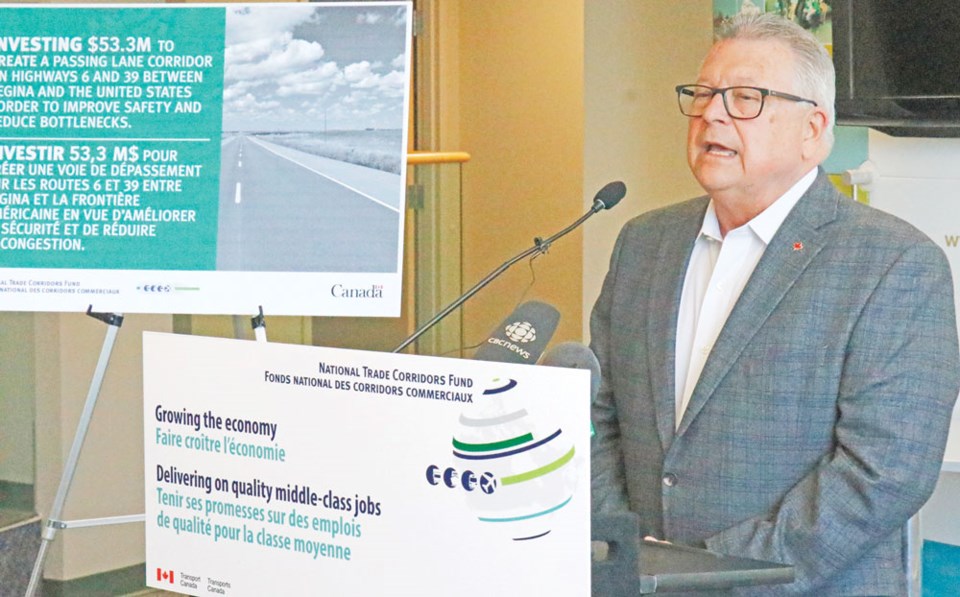The passing lanes and twinning that will be constructed on Highways 39 and 6 from Estevan to Regina have received a boost from the federal government.
Ralph Goodale, the federal minister of Public Safety and Emergency Preparedness, announced an investment of $53.3 million on Thursday in Weyburn.
The project consists of building 16 sets of passing lanes for Highways 39 and 6 between Estevan and Regina. It also includes twinning short segments, including Highway 6 south of Regina, and Highway 39 north of Milestone and south of Weyburn.
Also included is the rehabilitation of approximately 51 kilometres of pavement, and the improvement of intersections and highway entrances and exits along the corridor.
“Transportation and distribution of goods are a vital part of our local, regional and national economies,” Goodale said. “The investment announced here today will make our transportation system stronger by addressing capacity constraints and safety concerns along this corridor and fostering long-term prosperity for our community.”
The federal government previously contributed to the twinning of Highway 39 from an area east of Estevan to southeast of the junction of Highways 39 and 18. That project was completed last year.
Doug Wakabayashi, the executive director of communications and customer service for the Saskatchewan Ministry of Highways, said two sets of passing lanes are scheduled to be constructed south of Regina this year, and the rest of the project will go to tender soon.
But until the procurement process comes to a close, the full cost of the project won’t be released.
Wakabayashi said the government decided not to twin Highway 39 northwest of Estevan because the existing traffic numbers didn’t justify the work.
“We didn’t feel it was warranted at this time, especially with the truck bypass,” said Wakabayashi.
The twinning of Highway 39 east of the city wasn’t a factor in the decision not to twin northwest of the city.
It’s a decision the government could revisit at some point in the future.
“At some point in time, traffic volumes will get to the point where more twinning is warranted,” said Wakabayashi.
The government expects the passing lanes will take about five years to complete.
A decision hasn’t been made on whether construction of the passing lanes will south of Regina, and work its way towards Estevan, or if it will start outside of Regina and Estevan and then work its way to the middle.
“Delivery is something that will be proposed by the bidders on the contract,” said Wakabayashi. That’s one of the things they’ll be evaluated on is their plan for doing work.”
They could also start in the middle and work their way to Estevan and Regina.
“One of the things we do by giving bidders the flexibility to determine their own construction schedule is sometimes you can generate a cost-savings by tendering a job that way,” said Wakabayashi.
A decision hasn’t been made on which stretches of Highway 39 will be resurfaced, nor has the government decided where the intersection upgrades will occur. But the resurfacing will occur on older pavement.
“There are some efficiencies that can be gained by doing that at the same time as the contractors have their asphalt plants mobilized for paving the passing lanes,” said Wakabayashi.
The intersection improvements will include left-turn lanes and acceleration lanes.
The portion of Highway 39 south of Weyburn that will be twinned will extend to the Weyburn Inland Terminal building, he said, while the stretch north of Milestone will extend to around Corinne.
The twinned portion of Highway 6 south of Regina will extend beyond the junction with the Regina bypass.
There are not any plans at this point to add passing lanes to Highway 39 from the Roche Percee access road to North Portal, since the traffic volumes wouldn’t justify the work.
The local Time to Twin committee, though, still wants to see twinning from Regina to the U.S. border. Marge Young, who has co-chaired the committee with Lorelei Ireland since it started meeting in 2009, said she wasn’t surprised that the federal government supported the project.
“Putting in some passing lanes is not the answer,” said Young. “It’s a Band-Aid solution, and it’s what they’ve chosen to do because it suits them. It doesn’t suit us as a group. It doesn’t suit a lot of people in this area.”
She reiterated previous statements that passing lanes won’t enhance safety because of the number of semi-trailer units on the road.
“There is still a huge number of semis out there,” said Young. “Some people feel the oilfield is picking up, so it could get to be the crazy situation that it was a few years ago.”
Passing lanes will alleviate some of the issues on Highways 39 and 6, but not all of them.
Young said she is pleased to hear that some short sections of Highways 39 and 6 will have double lanes, but the committee believes the passing lanes mean the government won’t be looking at twinning.
“What’s the point of waiting to see if you’re spending that money on passing lanes? Do it properly the first time,” said Young.
The committee has been largely quiet since last summer when members met with David Marit, the Minister of Highways and Infrastructure. Young and committee member Norm Park met with Gord Wyant in January during the Saskatchewan Party’s leadership race, as Wyant reached out to them.
Wyant has since been named the deputy premier.
But the committee has been largely quiet in recent months, now that the government has told them passing lanes is the direction they have chosen.



